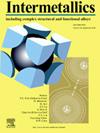吸铸和热机械加工对 TiNiCuNb 形状记忆合金微观结构和马氏体转变的影响
IF 4.3
2区 材料科学
Q2 CHEMISTRY, PHYSICAL
引用次数: 0
摘要
钛镍铜基超弹性合金有望用作弹性材料。在本研究中,我们的目标是生产出一种具有精细微观结构、足够的Af和潜热的TiNiCuNb合金,以用于室温应用。为此,我们通过电弧熔化和快速冷却真空吸铸(SC)生产出了 Ti48Ni38Cu10Nb4 合金。与只进行电弧熔炼的材料相比,该合金获得了更精细、更均匀的微观结构。这种微观结构在超弹性循环过程中表现出很高的稳定性,其Af值远远低于室温。进一步的热机械加工和热处理(HT)用于调整马氏体转变(MT)临界温度和焓。随着热处理温度的升高,Af 和焓也随之增加。讨论认为,除了复原/再结晶机制的发展影响外,钛镍基体中的铌含量也会影响这些特性。在 450 °C下热处理的合金的Af接近室温,但小于室温,MT焓为9.9 J/g。本文章由计算机程序翻译,如有差异,请以英文原文为准。
Effect of suction casting and thermomechanical processing on the microstructure and martensitic transformation of a TiNiCuNb shape memory alloy
TiNiCu-based superelastic alloys are promising for use as elastocaloric materials. In this study, we aim to produce a TiNiCuNb alloy with a refined microstructure, adequate Af, and latent heat for room-temperature application. For that, a Ti48Ni38Cu10Nb4 alloy was produced via arc melting followed by fast-cooling vacuum-suction casting (SC). Compared to the material that was only arc-melted, a refined and more uniform microstructure was obtained. This microstructure exhibited high stability during superelastic cycling and an Af much lower than room temperature. Further thermomechanical processing and heat-treatment (HT) were used to adjust the martensitic transformation (MT) critical temperatures and enthalpy. Increasing Af and enthalpy were observed with increasing HT temperatures. It was discussed that, besides the effect of the development of recovery/recrystallization mechanisms, the Nb content in the TiNi matrix could impact these properties. An Af close to, but smaller than room temperature, was obtained for the alloy heat-treated at 450 °C, with a MT enthalpy of 9.9 J/g.
求助全文
通过发布文献求助,成功后即可免费获取论文全文。
去求助
来源期刊

Intermetallics
工程技术-材料科学:综合
CiteScore
7.80
自引率
9.10%
发文量
291
审稿时长
37 days
期刊介绍:
This journal is a platform for publishing innovative research and overviews for advancing our understanding of the structure, property, and functionality of complex metallic alloys, including intermetallics, metallic glasses, and high entropy alloys.
The journal reports the science and engineering of metallic materials in the following aspects:
Theories and experiments which address the relationship between property and structure in all length scales.
Physical modeling and numerical simulations which provide a comprehensive understanding of experimental observations.
Stimulated methodologies to characterize the structure and chemistry of materials that correlate the properties.
Technological applications resulting from the understanding of property-structure relationship in materials.
Novel and cutting-edge results warranting rapid communication.
The journal also publishes special issues on selected topics and overviews by invitation only.
 求助内容:
求助内容: 应助结果提醒方式:
应助结果提醒方式:


